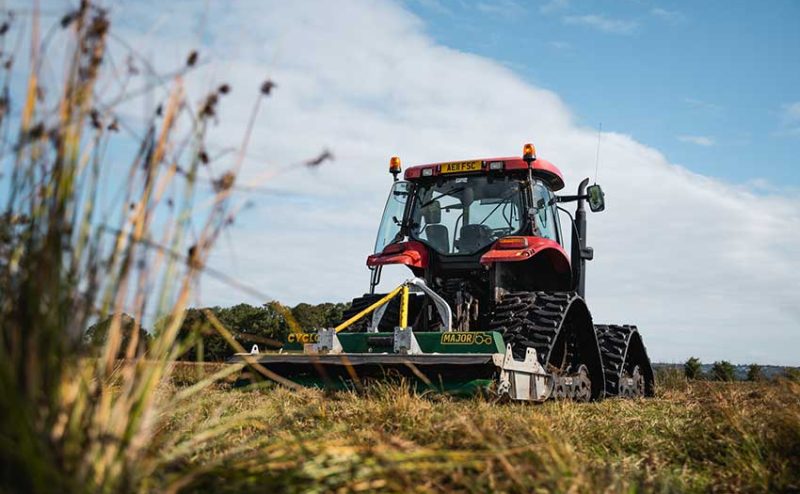
The RSPB in Northern Ireland pivoted away from costly flail mowers towards the Major Cyclone to control rushes and willow scrub areas at Lough Beg National Nature Reserve. The use of Cyclone mowers around the reserve are improving land conditions, thereby increasing flora and fauna populations while reducing operating costs and carbon emissions.
Lough Beg National Nature Reserve in Northern Ireland is a large wet grassland area covering 300 acres with Church Island as a focal point. Its site as a flood plain from the River Bann makes land management challenging.
The rapid decline of wading bird populations and the loss of rare wild orchids native to Lough Beg drew concern from environmentalists. The RSPB NI and their Countryside and Land Management Service (CLMS) implemented a strategy using specialist equipment and best practices to encourage regeneration of the natural habitat. By working closely with farmers to implement specific measures on their land, the RSPB NI is addressing and reversing the decline.
Paul Trimble is CLMS Business Manager at RSPB NI. “CLMS undertakes both the machinery management of our own Reserves, and also does contract work for external organisations, from statutory agencies and councils to private farmers and NGOs,” explains Paul. “An area of Lough Beg is considered ‘common’ ground and is under multiple ownership. CLMS has very specialised machinery which allows us to undertake work with landowners who have sensitive habitats to help them manage, as well as re-establish, the right conditions for birds, plants, mammals and invertebrates to thrive at Lough Beg.”
The CLMS team work to control the rushes and willow scrub in these sensitive areas to allow for adequate grazing. “It is important that the dense rushes are controlled, and willow and alder scrub at not given a chance to take over, so the land does not become unproductive,” Paul continues. “This could potentially lose the very species and habitats for which it was designated, with breeding sites being lost and flora smothered.” Carefully controlling the mosaic structure of the habitat improves the sward for stock, which improves nesting conditions for waders such as lapwing and redshank. This in turn creates a more suitable area for wild orchids and other species that require specific vegetation structure.
Some of the land around Lough Beg is heavily littered with large rocks and stones, which can make it difficult for conventional machinery. “We use a Case Quadtrac and a Case Maxxum tractor fitted with wide profile Soucy tracks to achieve a light ground pressure. This equipment enables travel across the very wet boggy conditions and avoids leaving ruts,” Paul elaborates. “For vegetation control we used to use flail toppers to chop the vegetation, but these would not handle the dense rushes and willow scrub effectively. And, they had serious issues with the rocks – some of which were two or three feet wide. Often a flail would break, the rotor would bend or go out of balance, shear bolts would break for a pastime, and it consumed a lot of time and expense in keeping the mowers functional.”
Paul laments a costly situation last year. “Our Case Quadtrac, which only had two thousand five hundred hours (2,500hours) on the clock had to undergo repairs. The vibration from the flail mowers caused cracks on the equipment. That’s not sustainable or cost-effective for an area of only three hundred (300) acres. We had to look at a better option.”
Paul and his team have moved away totally from flail machines to rotary mowers. “We upgraded significantly to much more reliable and lower power consuming Major Cyclone Rotary Mowers, which have proven to be far more cost-effective and reliable under these conditions,” enthuses Paul. “They also leave a better finish to the rush and willow scrub areas.”
They have three Cyclones altogether: one 2.8m and two 2.5m machines used at Lough Beg and on many other contract sites. “They easily handle all the rushes as well as the willow scrub and they just glance over rocks,” Paul beams. “On another site at Rathlin Island, we are working on a scrub clearance programme using one of the smaller machines and they have all performed so much better than the flail design. We set the cut height to about four inches and it chops almost anything, even two-inch willow scrub, which is much more efficient than the flails.”
Another advantage of the Cyclone is the even spread of residue. “It leaves a well cut, spread finish, with no windrow effect. It means we can prepare an open stubble finish, which the waders find more acceptable for nesting. Also, the rare orchids such as the Irish Ladies Tresses seem to find it much more suitable for their growing conditions.”
“There are four major benefits of using the Major Cyclone,” Paul defines. “Firstly, this year has seen a considerable reduction in our expenses for maintaining our mowers and tractors – I think we have only purchased one replacement blade throughout the year.”
“Secondly, the power consumption of the Major Cyclone is around fifty horsepower (50hp) ’less’ than the flail mower. That means lower fuel consumption and reduced carbon emissions.”
“Thirdly, the Major Cyclone is easy to maintain and set, plus it is manufactured from galvanised steel, therefore we see our investment lasting for many years to come.”
“Finally, they cost a lot less than a flail mower, which is a significant financial advantage to anyone wanting to maintain poor scrub sites and improve land areas. All around, this is informative for conservation managers and farmers alike.”